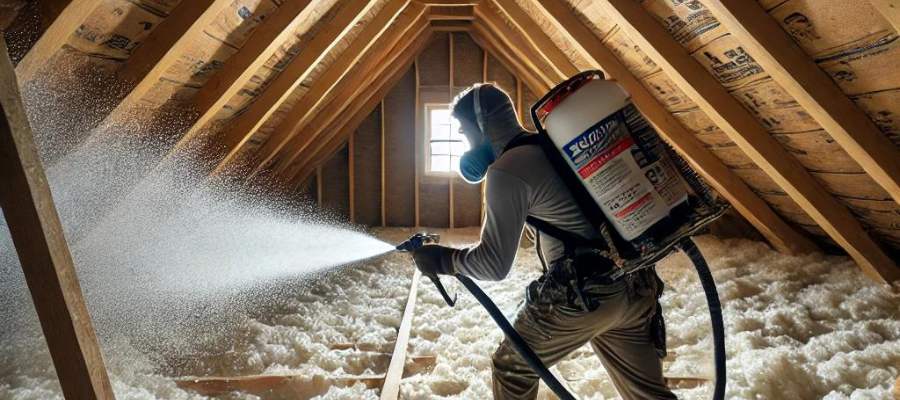Benefits, Costs, & Energy Savings of Spray-In Expanding Closed-Cell Foam Insulation
Spray-in expanding closed-cell foam insulation is a powerful tool in modern construction, offering superior energy efficiency, moisture resistance, and structural support. If you’re considering upgrading your insulation, understanding how this innovative material works, its benefits, and potential cost savings can help you make an informed decision.
What is Spray-In Expanding Closed-Cell Foam Insulation?
Spray-in expanding closed-cell foam insulation is applied as a liquid that expands into a thick, rigid foam, sealing gaps and creating an air-tight barrier. Unlike traditional insulation, this type of foam offers a dense structure that excels in energy efficiency, moisture protection, and pest resistance.

A Brief History of Foam Insulation
Foam insulation was first used in the mid-20th century for military and aerospace applications. Over time, its exceptional thermal properties led to widespread use in the construction industry, evolving into today’s highly effective closed-cell foam insulation.
How Does Spray-In Expanding Closed-Cell Foam Insulation Work?
Chemical Composition and Properties
Closed-cell foam insulation primarily consists of polyurethane or polyisocyanurate, renowned for their high R-value and minimal water absorption. When sprayed, these chemicals react to create millions of tiny, closed cells filled with gas, which boosts insulation efficiency.
The Expansion Process
The foam can expand up to 30 times its original liquid volume when applied, filling even the smallest cracks and crevices. This expansion forms a continuous and effective insulation barrier that enhances thermal resistance and strengthens the structure of walls, floors, and ceilings.
Application Techniques
Specialized equipment heats and pumps the foam components through a spray gun, adhering instantly to surfaces and curing within seconds. This quick application makes it ideal for new builds and retrofitting older structures.
Advantages of Spray-In Expanding Closed-Cell Foam Insulation
Energy Efficiency
Closed-cell foam insulation boasts an R-value of 6 to 7 per inch, one of the highest available. This high R-value significantly reduces heating and cooling costs by minimizing air leakage. This can also be considered part of overall weatherization.

Moisture and Water Resistance
Its dense, impermeable structure protects against water penetration, making it ideal for basements, crawl spaces, and other moisture-prone areas. This moisture resistance also helps prevent mold growth and water damage.
Enhanced Structural Strength
Once cured, closed-cell foam insulation adds rigidity and support to a building’s structure, beneficial in areas prone to high winds, earthquakes, or other structural stresses.
Soundproofing
The dense structure of closed-cell foam also helps block noise, making it a great option for homes or buildings in noisy environments, or for creating quiet indoor spaces.
Comparing Open-Cell and Closed-Cell Spray Foam Insulation
Key Differences
- Open-Cell Foam: Features a less dense, more flexible structure, suitable for interior walls and soundproofing.
- Closed-cell foam: This is a dense and rigid, ideal for exterior applications where moisture resistance and structural support are crucial.
Cost Considerations
Closed-cell foam is generally more expensive due to its higher density and superior insulating properties. However, its benefits, including long-term energy savings, often justify the higher initial cost.
R-Value and Thermal Performance
Understanding R-Value
R-value measures a material’s resistance to heat flow, with higher R-values indicating better insulation. Closed-cell foam insulation typically offers an R-value of 6 to 7 per inch, making it nearly twice as effective as traditional fiberglass insulation.
Impact on Energy Costs
The superior R-value of closed-cell foam can significantly reduce heating and cooling costs, offering substantial energy savings and reducing the environmental impact of maintaining indoor temperatures.

Environmental Impact and Sustainability
Manufacturing Advancements
While the production of spray foam insulation involves chemicals that raise environmental concerns, technological advances have led to more eco-friendly formulations, including those using water-based blowing agents.
Longevity and Recyclability
Though not biodegradable, closed-cell foam insulation’s durability means it rarely needs replacement, reducing the frequency of re-insulation projects. Some manufacturers also offer recycling programs for excess material.
Green Building Certifications
Buildings insulated with closed-cell foam may qualify for certifications like LEED, thanks to the energy savings and improved air quality the insulation provides.
Application Areas of Spray-In Expanding Closed-Cell Foam Insulation
Residential Applications
Closed-cell foam is commonly used in walls, roofs, attics, and basements. It’s particularly effective for sealing air leaks, insulating crawl spaces, and creating moisture barriers in bathrooms and kitchens.
Commercial and Industrial Uses
It’s ideal for insulating warehouses, cold storage facilities, and office buildings in commercial and industrial settings. Its ability to create a continuous barrier is invaluable for large projects.
Specialty Applications
Closed-cell foam is also used for insulating under slab foundations, around pipes, and in other challenging areas where traditional insulation fails.
Installation Process
Pre-Installation Preparation
Proper preparation includes cleaning surfaces, ensuring they are dry, and protecting areas from overspray. Structural issues should be addressed before the foam is applied.
Step-by-Step Installation
- Site Preparation: Cover surrounding areas with protective sheeting.
- Mixing Components: Prepare and mix chemicals using the spraying equipment.
- Application: Apply the foam evenly, ensuring all gaps are filled.
- Curing: Allow the foam to expand and harden, usually within minutes.
- Inspection: Check for any missed spots or uneven application.
Post-Installation Considerations
After curing, excess foam should be trimmed, and the area should be ventilated to allow any residual gases to dissipate.
Safety Considerations
Protective Gear
Installers must wear protective equipment such as respirators, gloves, and clothing to avoid exposure to chemicals that can cause skin irritation or respiratory issues.
Ventilation Requirements
Proper ventilation during and after installation is crucial to prevent harmful fumes from accumulating.
Health Effects of Improper Installation
Improperly installed foam can off-gas, leading to health issues such as headaches and respiratory problems. This emphasizes the importance of hiring experienced professionals.
Costs and ROI of Spray-In Expanding Closed-Cell Foam Insulation
Initial Costs
Spray-in expanding closed-cell foam insulation costs more upfront due to the specialized equipment and skilled labor required. However, the long-term energy savings often make it a cost-effective choice.
Long-Term Savings
The reduced energy bills from the improved insulation can help recover the initial investment within a few years, making it a financially sound option in the long run.
Comparing Costs with Other Insulation Methods
While more expensive than traditional methods like fiberglass or cellulose, the additional benefits of moisture resistance and structural reinforcement can make closed-cell foam worth the extra cost.
Common Myths and Misconceptions
Foam Shrinkage and Cracking
Modern closed-cell foams are designed to maintain their shape and integrity for decades, contrary to the misconception that they shrink and crack over time.
Environmental Concerns
Though concerns exist about the environmental impact of spray foam insulation, many manufacturers now offer low-VOC and eco-friendly options.
R-Value Misunderstandings
While R-value is important, air sealing and moisture resistance are equally crucial for overall insulation performance.
Maintenance and Longevity of Spray-In Expanding Closed-Cell Foam Insulation
Longevity
Closed-cell foam insulation is extremely durable, with a lifespan of 50 years or more, making it a long-term solution for energy efficiency.
Signs of Wear and Tear
Periodically inspect for signs like discoloration or gaps, indicating that the insulation has been compromised and needs attention.
Maintenance Tips
Regularly addressing issues like leaks or damaged areas helps maintain the effectiveness of the insulation, ensuring long-term protection.
Case Studies and Real-World Examples
Residential Success
Homeowners in colder climates have significantly reduced heating costs by using closed-cell foam insulation in their attics and walls.
Commercial Applications
A warehouse retrofitted with spray foam insulation achieved substantial energy savings and improved structural integrity.
Retrofitting Older Buildings
Older buildings retrofitted with closed-cell foam insulation often see dramatic energy efficiency and comfort improvements.
Choosing the Right Contractor for Installation
What to Look For
Experience, certification, and a solid track record are crucial when choosing a contractor. Ensure they are familiar with the latest installation techniques and safety protocols.
Important Questions
Ask about the contractor’s experience, equipment, and approach to potential issues. Inquire about warranties and post-installation support to ensure long-term satisfaction.
Certifications
Look for certifications from organizations like the Spray Polyurethane Foam Alliance (SPFA), which indicate a commitment to quality and expertise.
Frequently Asked Questions (FAQs)
- What is the difference between spray foam and traditional insulation? Spray foam insulation offers superior air sealing and a higher R-value per inch than traditional materials like fiberglass or cellulose.
- Can closed-cell foam insulation help with mold prevention? Yes, its moisture-resistant properties make it an excellent choice for preventing mold growth.
- How much does spray-in expanding closed-cell foam insulation cost? Costs vary but generally range from $1 to $3 per square foot, depending on project size and location.
- Is closed-cell foam insulation safe for residential use? When properly installed, it is safe and offers excellent thermal and moisture protection without harmful off-gassing.
- How long does the installation process take? Depending on the size of the area, most residential installations can be completed in a day or two.
- Does closed-cell foam insulation shrink over time? No, modern closed-cell foam is designed to maintain its shape, ensuring long-term performance.
Conclusion
Spray-in expanding closed-cell foam insulation is a superior solution for enhancing energy efficiency, structural integrity, and moisture resistance in residential and commercial buildings.

